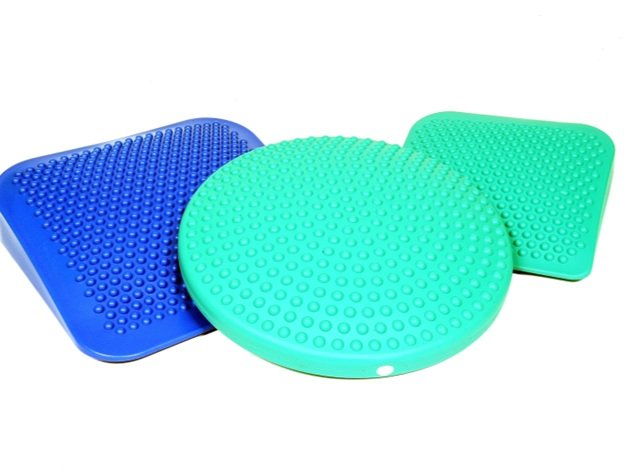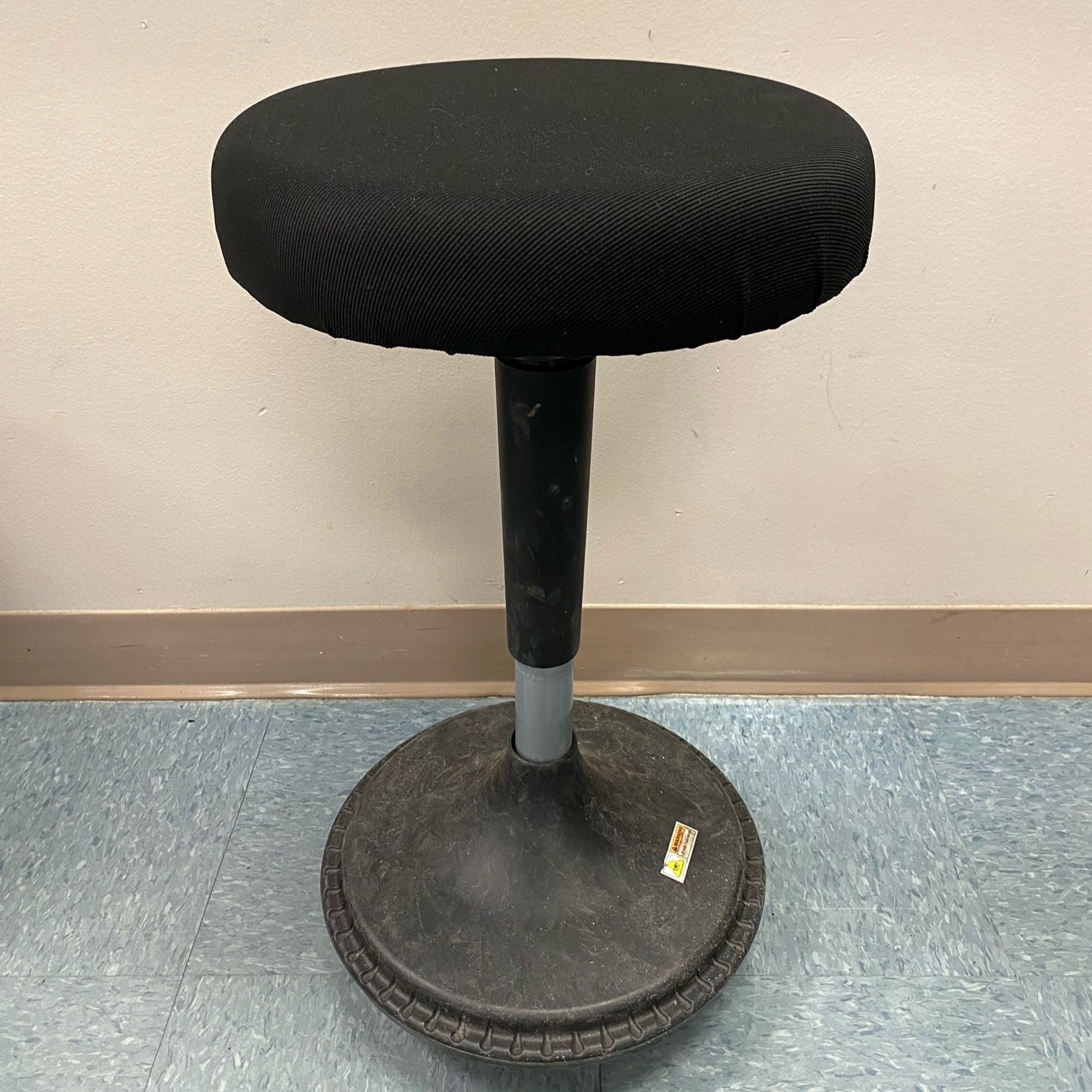Dynamic Seating
Dynamic seating refers to seating that allows the user to engage in movement within the seating system. Dynamic seating options are becoming more commonly used in classrooms, especially as a strategy to use with learners experiencing attention or sensory difficulties. Some types of dynamic seating include stability balls, wobble stools, rocking chairs, standing desks, and inflatable cushions.
Dynamic seating and the impact it can have for school-aged children with exceptionalities has been an interesting focal point for some recent research studies. These studies are showing promising evidence in favor of including dynamic seating in the classroom. Children with exceptionalities such as Autism Spectrum Disorder (ASD) and Down Syndrome (DS) exhibit inattention and distractibility more often than neurotypical children. This commonly leads to struggles at school, particularly with things like class participation, class engagement, attention, and inappropriate behaviors that hinder their ability to appropriately engage in educational activities (Matin Sadr et al., 2017). Dynamic seating is showing potential as an effective intervention to help students with exceptionalities in the classroom setting.
EXAMPLES OF DYNAMIC SEATING
-

Air Cushion
-

Wobble Stool
-

Therapy Ball
Key information & RECOMMENDATIONS
-
Studies have shown that classroom seating options often aren’t appropriately sized for all students in the classroom (Chung & Wong, 2007; Panagiotopoulou et al., 2004) . It is recommended that various sizes of chairs and desks be made available in the classroom so that students can find a seating arrangement that works for them (Gouvali & Boudolos, 2006).
-
A study from Krombach and Miltenberger (2019) aimed to investigate the impact that an intervention in the form of stability balls as an alternative seating method would have for children with ASD. The study took place in the homes of the children where they had previously been taking part in therapy sessions while seated in regular, plastic chairs. The participants were four children with ASD between the ages of 4 and 12. All four of the participants had demonstrated difficulty with seated tasks and remaining seated for more than 5 minutes during their therapy sessions. Baseline data was obtained with observation of the participants in their regular therapy sessions with no changes in seating. In the intervention phase, which lasted for 15-20 weeks, the regular seating was replaced with a therapy ball that was individually sized to each participant. The resulting data showed that there was a considerable improvement in the target behaviors for all four of the participants during the intervention. The participants could partake in self-stimulatory behavior by bouncing in the seats, though this did result in all of the participants falling off of the ball at least once. “The improvement in behavior was maintained over time and occurred regardless of student age or functioning level” (Krombach & Miltenberger, 2019, p. 555).
Another study related to dynamic seating (Matin Sadr et al., 2017) involved 15 students between the ages of 7 and 10 with ASD at Mashhad’s Tabasom School in Mashhad, Iran. The goal of the study was to determine if therapy balls and air cushions could have a positive impact on sitting and on-task behavior for the 15 students with ASD. On-task behavior and in-seat behavior were both measured, meaning that they collected data for on-task behavior whether a student was standing or sitting. On-task behavior, whether standing or sitting, was described as behavior “oriented towards appropriate classroom activity or teacher and either interacting with materials, responding to the speaker or looking at the speaker” (Schilling & Schwartz, 2004, as cited in Matin Sadr et al., 2017, p. 31). When using the therapy balls for seats, the results of the study showed a positive increase in on-task behavior while sitting in 86.7% of the students, and an increase of on-task behavior while not sitting in 53.3% of the students. The air-cushions had no significant effect on behavior. The therapy balls also showed a decrease in self-stimulatory behaviors and an increase in communication (Matin Sadr et al., 2017).
-
Reyneke & Hoosain (2020) aimed to determine if the use of stability balls as chairs would influence classroom behavior and task performance in learners with Down Syndrome. The participants in the study included three learners, aged ten to twelve years, with Down Syndrome. A single-subject withdrawal design was used within a special education classroom. The study incorporated five phases in total over the course of 6 months. Two phases incorporated regular classroom chairs, while three phases incorporated the stability balls as chairs. The researchers also included a novelty phase over the course of a month so that the students could become accustomed to the new seats. Classroom behaviors that were measured included in-seat (chair/ball), out of-seat, on-task, and off-task behavior. Results showed that the use of the stability balls as chairs led to a notable positive change in the learners’ on-task performance (Revneke & Hoosain, 2020). Improvements were observed in all three of the learners involved in the study with the implementation of the stability balls. When the students returned to their regular chairs, researchers observed a decline in on-task behavior. All participants and educators reported a positive outlook towards the stability balls as an alternate form of seating.
-
Gochenour and Poskey (2017) completed a literature review analyzing the effects that an alternative seating system can have on improving attention in students with attention difficulties. The authors did not conduct a study, but rather, they collected articles from peer-reviewed journals, compiling and critically appraising the information that they found. They only used articles that focused on students with attention difficulties, made use of alternative seating systems, and used attention levels in class as the outcome measure. Research showed that many students who have Attention Deficit Hyperactivity Disorder (ADHD) demonstrate difficulties detecting sensory input, modulating sensory input, and/or interpreting sensory input (Ghanizadeh, 2011, as cited in Gochenour & Poskey, 2017). This can have an impact on behavior at school. Alternate seating (e.g., therapy cushions, therapy balls, wobble stools, etc.) in a classroom has been shown to allow students with ADHD an opportunity to seek sensory input in a way that is appropriate for school and on-task behavior (Gochenour & Poskey, 2017). With alternative or dynamic seating being used, 66% of the articles measuring in-seat behavior showed an improvement in attention, while 50% of the articles that measured on-task behavior demonstrated an improvement in attention (Gochenour & Poskey, 2017).
-
Novel types of seating like stability balls, wobble stools, and air cushions can, at times, be a distraction for students. The studies from Krombach and Miltenberger (2019), Reyneke and Hoosain (2020), and Gochenour and Poskey (2017), all signaled the importance of modeling proper use of any new type of seating being used by children.